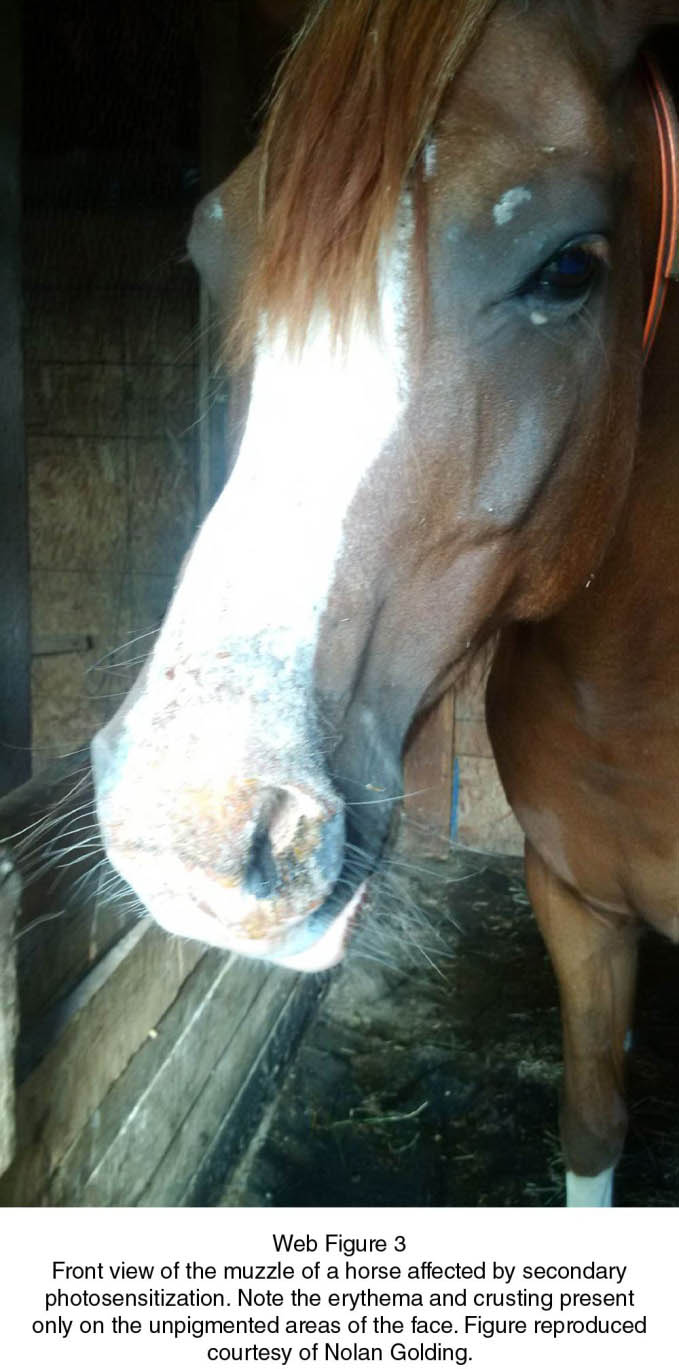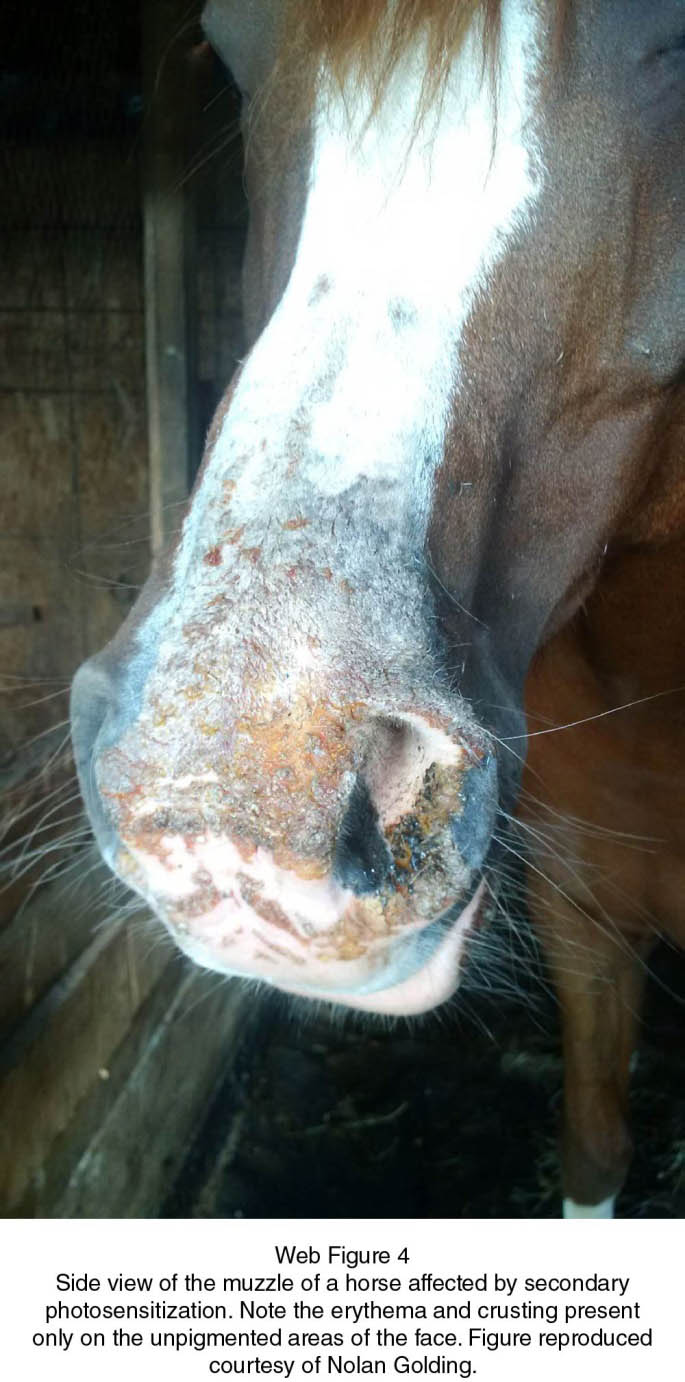- Definition
- Pathophysiology
- Systems Affected
- Genetics
- Incidence/Prevalence
- Geographic Distribution
- Signalment
- Signs
- Causes
- Risk Factors
- Photosensitization is defined as UV-induced dermatitis caused by a photodynamic agent in the skin which increases the sensitivity of the skin to sunlight
- Decreased skin pigmentation and hair cover facilitate cutaneous penetration of UV
- Upon exposure to UV, molecules of the photodynamic agent enter an excited or high-energy state. These excited molecules may cause skin damage directly but damage occurs mostly through the production of reactive oxygen metabolites and free radicals
- Photosensitization in horses generally fits into 1 of 2 categories: (1) primary photosensitization, which is caused when a preformed or metabolically derived photodynamic agent (e.g. plant or fungal products or chemicals) reaches the skin by ingestion, injection, or contact; and (2) secondary (hepatogenous) photosensitization, which occurs in cases of liver disease when phylloerythrin acts as a photodynamic agent
- Phylloerythrin, a porphyrin compound formed by microbial degeneration of chlorophyll in the intestine, is normally conjugated in the liver and excreted in the bile. Liver dysfunction and/or biliary stasis may result in the accumulation of phylloerythrin in the blood and body tissues, including the skin. Some toxins derived from grasses are directly phototoxic and hepatotoxic, which makes the above classification of photosensitization less clear
- Skin/exocrine—lesions usually restricted to light-skinned, sparsely haired areas such as the coronary band, muzzle, ears, eyelids, tail, and vulva
- Hepatobiliary—secondary photosensitization can be associated with any cause of hepatic insufficiency. However, it appears to be more commonly associated with hepatic insufficiency caused by the ingestion of hepatotoxic plants
- Initial signs noted are restlessness and scratching and rubbing of the ears, eyelids, and muzzle
- Shade-seeking behavior
- Demarcated skin lesions characterized by redness, blister formation; weeping, and crusting
- In cases of secondary photosensitization owners may notice signs suggestive of liver failure (e.g. altered mentation, weight loss, abdominal pain, diarrhea, etc.)
PhysicalExamination Findings (Web Figures 3 and 4)

Cutaneous Lesions (Primary and Secondary Photosensitization)
- Usually restricted to sparsely haired, light-skinned areas on the dorsal aspects of the body (e.g. face, muzzle, eyelids, ears, coronary bands, vulva, and tail), but in severe cases can extend to dark-skinned areas
- Demarcation between lesions and normal skin is quite clear, particularly in multicolored animals
- Acute signs include erythema, edema, serous exudation, and crust formation; lesions may be sensitive to touch and/or pruritic
- As lesions become more chronic, crust formation and sloughing of the skin is noted
- Conjunctivitis, keratitis, and corneal edema may be seen
Causes of Primary Photosensitization
- Associated with ingestion, injection, or contact with a photodynamic agent
- Photodynamic plants (e.g. St. John's wort (Hypericum perforatum), buckwheat (Fagopyrum esculentum), perennial ryegrass (Lolium perenne), burr trefoil (Medicago denticulata), spring parsley (Cymopterus watsoni), bishop's weed (Ammi majus), oat grass (Avena fatua), rape (Brassica spp.), Dutchman's breeches (Thamnosma texana), alsike clover (Trifolium hybridum), alfalfa (Medicago spp.), vetches (Vicia spp.), hogweed (Heracleum sphondylium), gluten, etc.)
- Chemicals (e.g. phenothiazines, thiazides, acriflavines, methylene blue, sulfonamides, tetracyclines, coal tar derivatives, furosemide, promazine, chlorpromazine, quinidine, rose bengal, etc.)
- Mycotoxins (e.g. phycocyanin produced by blue-green algae and phytoalexins produced by celery and parsnip)
Causes of Secondary Photosensitization
- Associated most often with chronic liver failure or conditions that result in biliary obstruction
- Chronic active hepatitis
- Hepatic abscessation
- Neoplasia (cholangiocellular carcinoma, lymphosarcoma)
- Chronic megalocytic hepatopathy (Senecio spp., Crotalaria spp., Heliotropium spp.)
- Burning bush, fireweed (Kochia scoparia)
- Mycotoxicoses (blue-green algae (Microcystis spp.), Phomopsis leptostromiformis (on lupines))
- Cholelithiasis/cholangitis
 BASICS
BASICS
 DIAGNOSIS
DIAGNOSIS TREATMENT
TREATMENT MEDICATIONS
MEDICATIONS FOLLOW-UP
FOLLOW-UP MISCELLANEOUS
MISCELLANEOUS